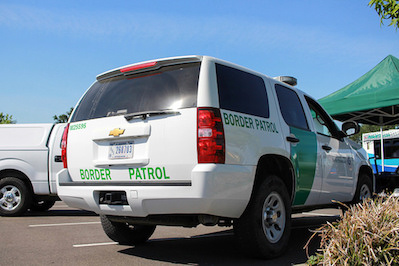No Need to Build Donald Trump’s Wall — Its Logic Is Already Being Practiced
A draconian Border Patrol program may not be Trump's promised structure, but it embodies the logic of his "wall": Either you crossed illegally or you didn’t. And it is just one of many tough U.S. programs developed in recent decades. In the 25 years before Trump's presidential run, the number of Border Patrol agents more than quintupled, from 4,000 to more than 21,000. (_schmal / Public Domain)
1
2
3
4
In the 25 years before Trump's presidential run, the number of Border Patrol agents more than quintupled, from 4,000 to more than 21,000. (_schmal / Public Domain)
1
2
3
4

In the 25 years before Trump’s presidential run, the number of Border Patrol agents more than quintupled, from 4,000 to more than 21,000. (_schmal / Public Domain)
At the federal courthouse, Ignacio Sarabia asks the magistrate judge, Jacqueline Rateau, if he can explain why he crossed the international boundary between the two countries without authorization. He has already pleaded guilty to the federal misdemeanor commonly known as “illegal entry” and is about to receive a prison sentence. On either side of him are eight men in the same predicament, all still sunburned, all in the same ripped, soiled clothes they were wearing when arrested in the Arizona desert by agents of the U.S. Border Patrol.
Once again, the zero tolerance border enforcement program known as Operation Streamline has unfolded just as it always does here in Tucson, Arizona. Close to 60 people have already approached the judge in groups of seven or eight, their heads bowed submissively, their bodies weighed down by shackles and chains around wrists, waists, and ankles. The judge has handed out the requisite prison sentences in quick succession — 180 days, 60 days, 90 days, 30 days.
On and on it goes, day-in, day-out. Like so many meals served in fast-food restaurants, 750,000 prison sentences of this sort have been handed down since Operation Streamline was launched in 2005. This mass prosecution of undocumented border crossers has become so much the norm that one report concluded it is now a “driving force in mass incarceration” in the United States. Yet it is but a single program among many overseen by the massive U.S. border enforcement and incarceration regime that has developed during the last two decades, particularly in the post-9/11 era.
Sarabia takes a half-step forward. “My infant is four months old,” he tells the judge in Spanish. The baby was, he assures her, born with a heart condition and is a U.S. citizen. They have no option but to operate. This is the reason, he says, that “I’m here before you.” He pauses.
“I want to be with my child, who is in the United States.”
It’s clear that Sarabia would like to gesture emphatically as he speaks, but that’s difficult, thanks to the shackles that constrain him. Rateau fills her coffee cup as she waits for his comments to be translated into English.
Earlier in April 2016, Republican presidential candidate Donald Trump, still in the heat of his primary campaign, stated once again that he would build a massive concrete border wall towering 30 (or, depending on the moment, 55) feet high along the 2,000 mile U.S.-Mexican border. He would, he insisted, force Mexico to pay for the $8 billion to $10 billion barrier. Repeatedly throwing such red meat into the gaping jaws of nativism, he has over these last months also announced that he would create a major “deportation force,” repeatedly sworn that he would ban Muslims from entering the country (a position that he regularly revises), and most recently, that he would institute an “extreme vetting” process for foreign nationals arriving in the United States.
In June 2015, when he rode a Trump Tower escalator into the presidential campaign, among his initial promises was the building of a “great” and “beautiful” wall on the border. (“And no one builds walls better than me, believe me. I will do it very inexpensively. I will have Mexico pay for that wall.”) As he pulled that promise out of a hat with a magician’s flair, the actual history of the border disappeared. From then on in Election 2016, there was just empty desert and Donald Trump.
Suddenly, there hadn’t been a bipartisan government effort over the last quarter-century to put in place an unprecedented array of walls, detection systems, and guards for that southern border. In those years, the number of Border Patrol agents had, in fact, quintupled from 4,000 to more than 21,000, while Customs and Border Protection became the largest federal law enforcement agency in the country with more than 60,000 agents. The annual budget for border and immigration enforcement went from $1.5 to $19.5 billion, a more than 12-fold increase. By 2016, federal government funding of border and immigration enforcement added up to $5 billion more than that for all other federal law enforcement agencies combined.
Operation Streamline, a cornerstone program in the “Consequence Delivery System,” part of a broader Border Patrol deterrence strategy for stopping undocumented immigration, is just one part of a vast enforcement-incarceration-deportation machine. The program is as no-nonsense as its name suggests. It’s not The Wall, but it embodies the logic of the wall: either you crossed “illegally” or you didn’t. It doesn’t matter why, or whether you lost your job, or if you’ve had to skip meals to feed your kids. It doesn’t matter if your house was flooded or the drought dried up your fields. It doesn’t matter if you’re running for your life from drug cartel gunmen or the very army and police forces that are supposed to protect you.
This system was what Ignacio Sarabia faced a few months ago in a Tucson court. His tragedy is one that plays out so many times daily a mere seven blocks from where I live.
Before I tell you how the judge responded to his plea, it’s important to understand Sarabia’s journey, and that of so many thousands like him who end up in this federal courthouse day after day. As he pleads to be with his newborn son, his voice cracking with emotion, his story catches the already Trumpian-style of border enforcement — both the pain and suffering it has caused, and the strategy and massive build-up behind it — in ways that the campaign rhetoric of both parties and the reporting on it doesn’t. As reporters chase their tails attempting to explain Trump’s wild and often unfounded claims and declarations, the on-the-ground border reality goes unreported. Indeed, one of the greatest “secrets” of the 2016 election campaign (though it should be common knowledge) is that the border wall already exists. It has for years and the fingerprints all over it aren’t Donald Trump’s but the Clintons’, both Bill’s and Hillary’s.
Your support matters…Independent journalism is under threat and overshadowed by heavily funded mainstream media.
You can help level the playing field. Become a member.
Your tax-deductible contribution keeps us digging beneath the headlines to give you thought-provoking, investigative reporting and analysis that unearths what's really happening- without compromise.
Give today to support our courageous, independent journalists.






You need to be a supporter to comment.
There are currently no responses to this article.
Be the first to respond.